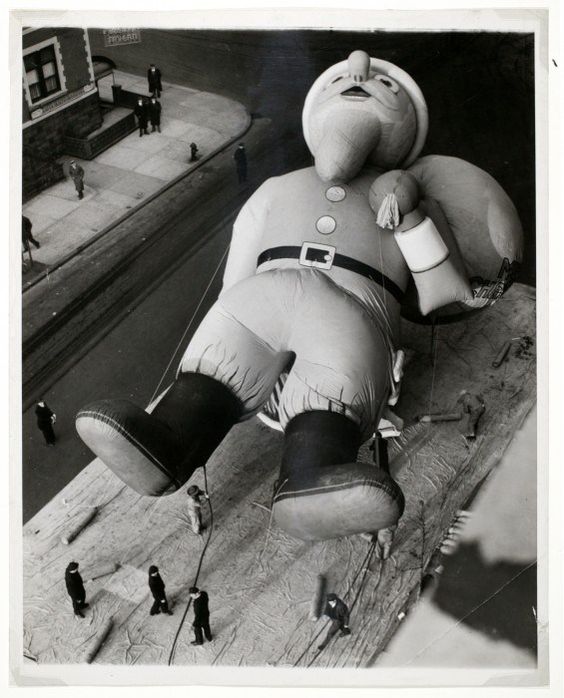Eu tive a oportunidade e o prazer de participar do SVA Design Writing and Research Summer Intensive. Foi uma experiência incrível para experimentar diferentes métodos de pesquisa e formatos de escrita. A proposta feita por Adam Harrison Levy era criar uma narrativa a partir de uma imagem tirada pelo legendário fotógrafo novaiorquino Weegee. Fui presenteada com a imagem do balão de papai Noel sendo inflado para a parada do dia de ação de graças promovida pela loja de departamento Macy‘s. Eu gostaria de dividir essa história de Natal.
Esse texto foi originalmente escrito em inglês, não foi traduzido para português.
Esse texto foi originalmente escrito em inglês, não foi traduzido para português.
I had the pleasure to be part of the SVA Design Writing and Research Summer Intensive. It was a amazing opportunity to experiment with different research methods and writing formats. Adam Harrison Levy's assignment was to create a narrative story inspired by pictures of the legendary photographer Weegee. The picture that was given to me was the Macy's Thanksgiving Day Parade Santa Claus ballon. I would like to share with you this Christmas Story.
The photographer known for his tight close-ups of arrested criminals, celebrities or everyday new yorkers, usually looks his subjects directly in the eye. Here he trains his camera on a character that can’t look at him. He is laid on the floor and has bulging eyes but he is not dead, actually he is waking up in the early morning. Forty-five foot high, he is the super hero of the holiday season: the floating Santa balloon in the 1940 annual Thanksgiving Day Parade of R. H. Macy’s in Midtown Manhattan.
In the summer of 1940, Weegee was hired by the New York daily newspaper PM. Along with his more typical photos of crime scenes, he also used to take pictures of the city. He was asked to deliver stories about common people, looking for what they used to do during their free time and on holidays. The Thanksgiving Parade balloons were inflated early in the morning and the photographer had a special interest in them, shooting other characters such as clowns and animals. The Santa balloon was a familiar figure at the parade and stood together with the live flesh and blood version of Santa Claus, known for climbing the Macy’s storefront. The gigantic figure was designed in 1939 by the puppeteer and illustrator Tony Sarg and was the biggest balloon at the time. The picture was taken in November 21, 1940. While 12 men, 8000 cubic meters of helium gas, 150 cubic feet of protecting canvas and a vacuum cleaner were combining efforts during two hours to bring Santa Claus to life, Weegee couldn’t know that he was witnessing the Santa balloon’s last appearance.
In the next years the helium-filled reproduction of Santa Claus would not be there again. In 1941 Santa would lead the procession of seven big balloons, but collapsed just before the start of the parade and had to be carted off in a truck. Fifty thousand spectators at the 106th Street were disappointed while Santa deflated in front of their eyes. In the year of 1942 the president of Macy’s, Jack I. Straus, in a patriotic movement, announced that the department store would not hold the parade that year because of war efforts and a shortage of rubber and helium. The waste of gasoline and the required service of 3000 policeman also were considered in this decision. In a ceremony held on the City Hall seven giant balloons were donated to the government’s rubber scrap adding 650 pounds to the pile to be converted to rubber for tanks and planes. Superman, a reluctant dragon, a clown, a goldfish, a pink dumbo, a football player (which some people suspected was the superman of 1940 repainted) and Santa Claus were sacrificed. As a farewell, the dragon was inflated with air for the last time in order to be punched by a new specimen of Saint George: the Mayor of New York La Guardia. In the next 2 years, Macy’s kept the decision to eliminate the parade.
1945 brought a reason to celebrate. Hope was back into the air and so were the balloons. With the end of the war, Goodyear was again able to produce for the department store the giant flying characters. Not anymore with the unique design made famous by Tony Sarg, as he died in 1942. A new era was coming. The balloons were enlisted to the war but they managed to return to the enlightenment of the city, for the joy of Macy’s marketing team and the good of the sales.
